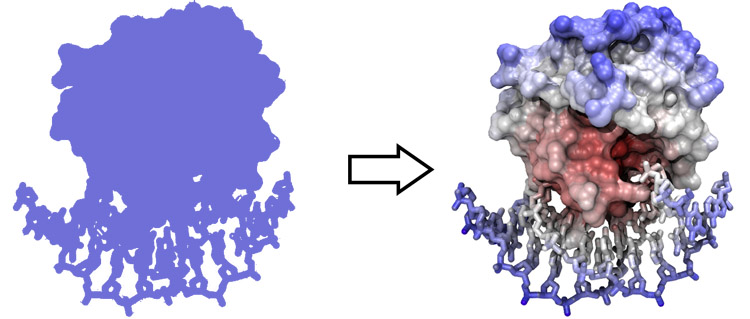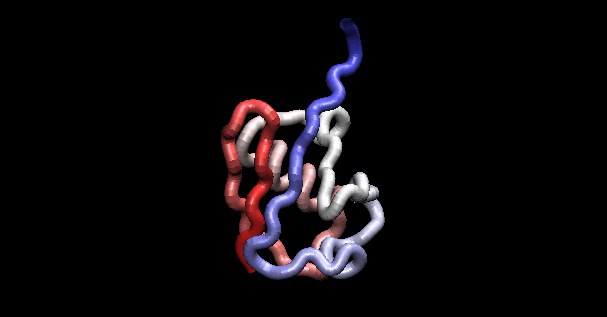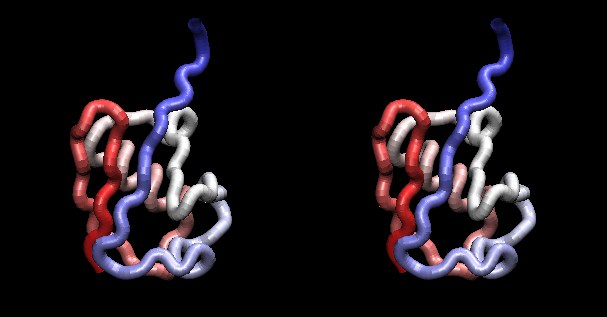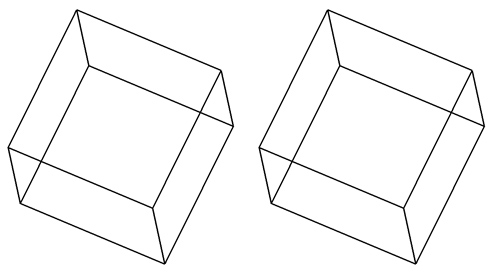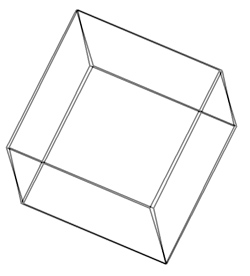Difference between revisions of "Stereo Vision"
| Line 1: | Line 1: | ||
| + | <div style="padding: 5px; background: #A6AFD0; border:solid 1px #AAAAAA; font-size:200%;font-weight:bold;"> | ||
| + | Stereo Vision | ||
| + | </div> | ||
| + | |||
| + | | ||
| + | | ||
| + | |||
| + | |||
| + | |||
| + | |||
==Introduction== | ==Introduction== | ||
Being able to visualize and experience strucutre in 3-D is an essential skill, if you are at all serious about understanding the molecules of molecular biology. This is not sufficiently realized in the field: many molecular biologists in the field have never invested the effort it takes to learn the skill and thus get by regardless. The catch is: unless you have experienced and worked with stereo images, there is no way of understand how much you are actually missing. But once you have used the skill, you'll regret not having been taught earlier. Seing molecules in 3-D is like the difference between seing a photograph of a place and actually being there. In 3-D you can apreciate size, scale, distance, spatial relations all at a single glance. I would claim: '''you can't understand structure unless you experience it in 3D'''. | Being able to visualize and experience strucutre in 3-D is an essential skill, if you are at all serious about understanding the molecules of molecular biology. This is not sufficiently realized in the field: many molecular biologists in the field have never invested the effort it takes to learn the skill and thus get by regardless. The catch is: unless you have experienced and worked with stereo images, there is no way of understand how much you are actually missing. But once you have used the skill, you'll regret not having been taught earlier. Seing molecules in 3-D is like the difference between seing a photograph of a place and actually being there. In 3-D you can apreciate size, scale, distance, spatial relations all at a single glance. I would claim: '''you can't understand structure unless you experience it in 3D'''. | ||
Revision as of 16:01, 9 September 2008
Stereo Vision
Contents
Introduction
Being able to visualize and experience strucutre in 3-D is an essential skill, if you are at all serious about understanding the molecules of molecular biology. This is not sufficiently realized in the field: many molecular biologists in the field have never invested the effort it takes to learn the skill and thus get by regardless. The catch is: unless you have experienced and worked with stereo images, there is no way of understand how much you are actually missing. But once you have used the skill, you'll regret not having been taught earlier. Seing molecules in 3-D is like the difference between seing a photograph of a place and actually being there. In 3-D you can apreciate size, scale, distance, spatial relations all at a single glance. I would claim: you can't understand structure unless you experience it in 3D.
Even though hardware devices exist that help in the three-dimensional perception of computer graphics images, for the serious structural biologist there is really no alternative to being able to fuse stereo pair images by looking at them. VMD is an excellent tool to practice stereo vision and develop the skill. Stereo images consist of a left-eye and a right-eye view of the same object, with a slight rotation around the vertical axis (about 5 degrees). Your brain can accurately calculate depth from these two images, if they are presented to the right and left eye separately. This means you need to look at the two images and then fuse them into a single image - this happens when the left eye looks directly at the left image and the right eye at the right image.
Some people find convergent (cross-eyed) stereo viewing easier to learn. I recommend the divergent (wall-eyed) viewing - not only because it is much more comfortable in my experience, but also because it is the default way in which stereo images in books and manuscripts are presented. The method explained below will only work for learning to view divergent stero pairs.
Physiology
In order to visually fuse stereo image pairs, you need to override a vision reflex that couples divergence and focussing, this is something that needs to be practiced for a while. Usually 5 to 10 minutes of practice twice daily for a week should be quite sufficient. It is not as hard as learning to ride a bicycle, but you need to practice regularily for some time, maybe 10 or 20 sessions of 3 to 5 minute over a period of a week or two. Once you have acquired the skill, it is really very comfortable and can be done effortlessly and for extended periods. You will enter a new world of molecular wonders !
Instructions
Here are step by step instructions of how to practice stereo-viewing with VMD.
- Load a small protein into VMD (1UBQ will work just fine) and display this as a simple backbone model.
- VMD Main → Representations → Drawing Method: Tube
- Increase the tube radius to 1.0; choose coloring by Index.
- Set the stereo display to SideBySide:
- VMD Main → Display → Stereo → SideBySide
- Resize the window, until two equivalent points on the protein are the same distance on the screen as the pupils of your eyes are apart (the average interocular separation is about 6.5 cm). Don't just guess, measure the distance, and adjust your on-screen scene to better than two or three millimetres of the correct separation.
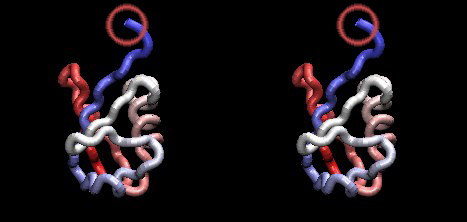
You should resize the window of your molecular viewer (VMD) until equivalent points are the correct distance apart, they should match as nearly as possible your interocular separation. The two circles indicate equivalent points of the image. They are 232 pixels apart, their physical separation on the screen depends on your monitor resolution. On my screen they are 5.2 cm apart, too close for most people.
- Touch your nose to the screen and look right at the two images. Make sure you see the right image with your right eye, the left with your left eye. Of course, since you are so close, the images will be blurred and out of focus. Nevertheless, you should see one solid, three dimensional shape in the centre, two peripheral images of the same on the sides. Actually you see three copies of the same scene, but only the fused, centre scene appears three-dimensional; the other two become less noticeable as you practice more, your brain simply begins editing them out. Slowly rotating the protein with the mouse helps generate the impression of a 3-D object floating before you. (With VMD you can use the mouse to give the molecule a slow spin and it will continue to rotate). You could also type rock y by 0.2 50 into the VMD command window.
- Once you see the object in 3-D, try to move your head backwards slowly, until the structure comes into focus by itself. Do not voluntarily try to focus, since this will induce your eyes to converge and you will lose the 3-D effect. After a short while, you will probably lose the 3-D effect. Once you lose the 3-D effect, pause, look somewhere else and start over.
- Practice this patiently, two times daily for some 3 to 5 minutes. Stop, when your head feels funny. Don't force yourself.
- After time and with practice, it will become easier and easier to achieve the effect. Also you will become quite independent of the distance of equivalent points, thus you can increase the viewer window size and take advantage of the increased resolution.
It should take you about a week to master this, with regular training it will become very easy. And, the best thing is, you do not easily forget this skill. It is like riding a bicycle, equalizing pressure in your ears while scuba diving, or circular breathing to play the didgeridoo: once you teach your body what to do, it remembers.
Examples
Here are example scenes to practice stereo viewing. You could also refer to the Stereo Vision Exam Questions.
Abstract Shapes
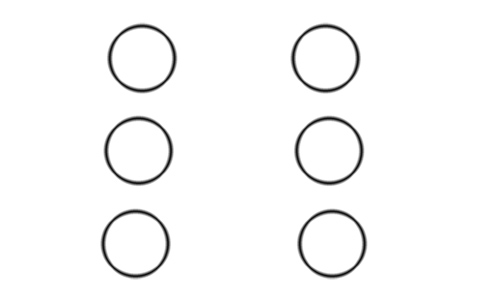
Side by side stereo image. These are three circles staggered from front (top) to back (bottom). There are no secondary visual depth-cues at all, such as perspective drawing, size changes or occlusions. Once you see the circles in stereo however, their spatial relationship should become vividly obvious.
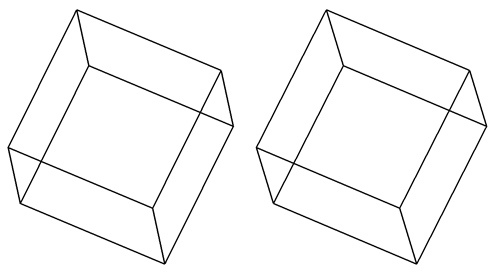
Side by side stereo image. This is a simple cube, drawn in orthographic projection and sligthly rotated. Other than the pseudo-perspective angling of the lines going towrads the back, there are no secondary visual depth-cues, such as occlusions or shading. This makes the 2D representation ambiguous regarding which face is closer to the viewer. If you look at only one of the images, you should be able to mentally invert the cube back-to front. In fact, when you concentrate on seeing the cube in a particular way, it becomes impossible to maintain this interpretation for more than abou ten seconds or so: your visual system forces the switch and thus explores all of the ambiguous interpretations. Once you see the cube in stereo however, it becomes clear that the face further to the left is closer to you. Concentrating on the image in stereo enforces the correct interpretation, rather than causing a switch.
2MCP.PDB
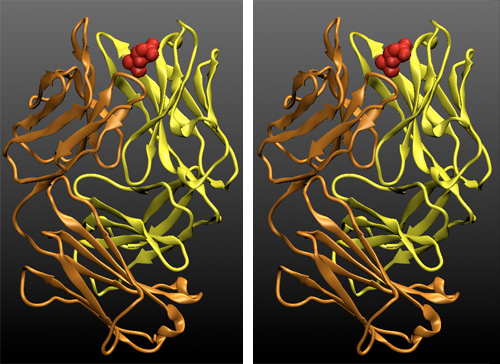
Side by side stereo image. The two chains of the Fab fragment of the phosphocholine-binding antibody McPC603 are shown in a cartoon representation, the light chain is in yellow (VL and CL domain), the two domains of the heavy chain are shown in orange (VH and CH1 - The CH2 and CH3 domains are part of the Fc fragment, not shown here). The bound hapten phosphorylcholine is shown in red in a surface representation.
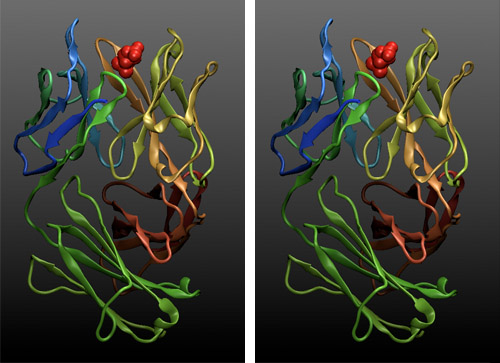
Side by side stereo image. The two chains of the structure have been color-ramped according to their atom-index in the PDB file to highlight the overall fold of the four domains. These are so-called greek-key beta barrels: each domain comprises a two-sheet barrel with a hydrophobic core. The chain meanders first through half of the first sheet, crosses over the top of the domain, creates half of the other sheet, crosses back along the side, completes the first sheet, crosses under the domain and completes the second sheet. In stereo, it is easy to trace the chain architecture by eye.
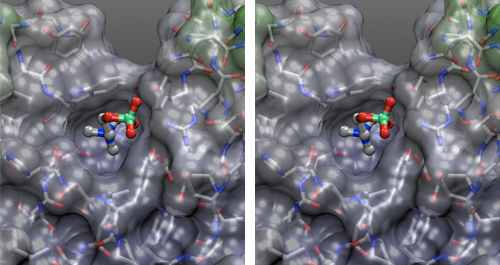
Side by side stereo image. A transparent solvent-accessible surface, lightly shaded by position has been laid over a licorice representation of the protein atoms. A ball-and-stick (CPK) representation was used for the hapten. Elements are color coded red for oxygen, silver for carbon, blue for nitrogen; phosphorous is green. In this representation we can discern element types and bonding topology of the structure, as well as the shape of the binding site that the protein conformation has generated. A deep binding pocket accommodates the choline end of the hapten, the phosphate group is exposed to solvent. All molecular features of the hapten are discretely used in binding: the two oxygen atoms of a negatively charged aspartic acid can be seen at the bottom of the binding pocket, offsetting the positively charged trimethylammonium group of choline. Conversely, a positively charged arginine sidechain at the top, right, forms a saltbridge with the neagtively charged phosphate group. A tyrosine above the arginine hydrogen bonds one of the phosphate oxygens, while the hydrophobic sides of the binding pocket are formed by a tryptophan sidechain (top) and a tyrosine sidechain (bottom).
Common problems
Some people get confused as to what they are supposed to see. What you see is two representations with each eye, i.e. four representations. The two central images (image L as seen with the left eye, image R as seen with the right eye) should overlap so that the images fuse in your visual system to create one 3-D image. The two peripheral images still remain, just don't concentrate on them and your visual system will edit them out of consciousness as you gain experience.
There are two situations which interfere strongly with stereo vision. One such situation is if the images presented to your eye are of unequal size. This can happen if you are using glasses with significantly different correction for each eye - the lenses then have different magnifications. The other situation is if equivalent points of the images are verticaly misaligned, i.e. one of the images is shifted up or down, or rotated. This can occcur when your head is tilted relative to the image. Keep it straight.
Images that are difficult to see in 3-D are also images that are rendered differently for the left- and right view: non-aligned jagged edges, differing shadows or highlights disturb the stereo effect. To prevent this, try to apply visual effects judiciously. VMD is quite good with it's rendering but e.g. specular highlights in RasMol are quite inconsistent between left and right. (If you are a programmer, remember to write your code to move the camera location, don't rotate the object because that will incorrectly change shadowing.)
Of course, if you are learning Side By Side viewing, so-called cross-eyed images will be wrong for you. They look like the real thing, but the left-eye view is on the right-hand side and vice versa. You can tell that they are wrong when you achieve the image fusion but the 3-D efect seems to be all wrong. This is because the image becomes inverted in depth: near points appear far away and vice versa. If you are looking at a simple line drawing, you can't tell that this is happening. However if there are any secondary depth cues in the image, such as occlusions, shadows, highlights etc, they are in the wrong places and won't work to enhance the depth effect.
Resources and References
- Stereopsis - Wikipedia article on why we see in three dimesions
- Stereoscopy - Wikipedia article on the techniques for stereo images
